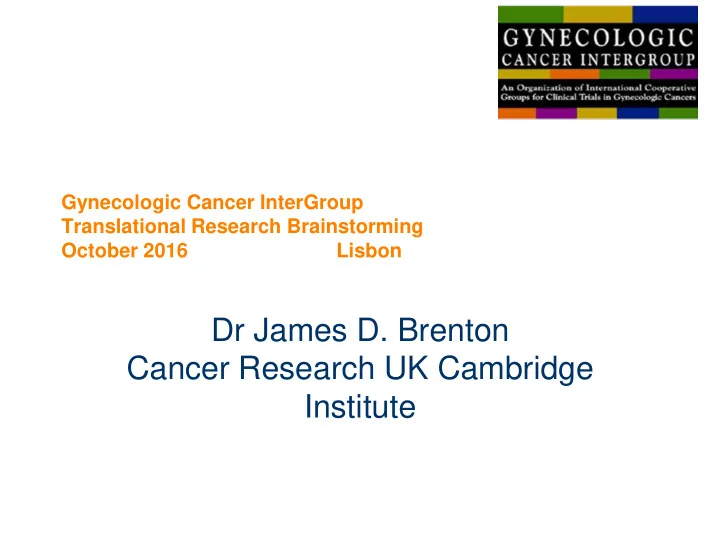

Gynecologic Cancer InterGroup Translational Research Brainstorming October 2016 Lisbon Dr James D. Brenton Cancer Research UK Cambridge Institute
How can we achieve an integrated cancer medicine approach for women with HGSOC? Tissue biopsy Liquid biopsy Imaging Highly annotated record Model-based clinical data capture
TP53 Clonal marker Tissue biomarker Plasma biomarker p53 IHC as a TP53 circulating DNA Absolute copy number diagnostic biomarker as a response assay estimation
Analytical reliability in HGSOC
Exploratory comparison of ctDNA quantification to CA125 Christine Parkinson Davina Gale Anna Piskorz Nitzan Rosenfeld
3D volume analysis from CT imaging ROI calculated by outlining volumes in Syngo.via (Siemens)
What volume of disease is detectable?
Correlation of volume with ctDNA and CA-125
Nadir value is reached earlier for ctDNA than CA-125
Ascites is a “third space” for cfDNA
ctDNA rise in brain metastasis
ctDNA fall after 1 cycle of chemotherapy predicts 6 month PFS
Ongoing analyses in current trials • PHL093 Phase II trial evaluating gemcitabine/AZD 1775 in platinum resistant ovarian cancer • Rucaparib in relapsed, platinum-sensitive high-grade ovarian carcinoma (ARIEL2 Part 1): an international, multicentre, open-label, phase 2 trial • PiSARRO: a EUTROC Phase Ib Study of APR-246 with Carboplatin (C) and Pegylated Doxorubicin (PLD) in Relapsed Platinum-Sensitive High Grade Serous Ovarian Cancer (HGSOC)
Why is absolute copy-number critical? • Accurate CN comparison between samples • Accurate identification of loss/gain of actionable drivers • Ability to use genome-wide CN based prognostic measures such as the complex aberration index* Can we do it cheaply in a clinical workflow and use DNA from FFPE ? * Vollan et al Mol. Oncology 2015, Lartigue et al EJC 2015, or Schwartz et al, PLoS Med 2015
Why is this important? • May provide a “formal grammar” to interpret genomic profiles of HGSOC and development of more powerful molecular classification • Immediately applicable to large FFPE collections (e.g. OTTA, and trials including ICON7, ICON8). • Genometypes may be important candidate covariates for • Nanostring gene expression signatures • Molecular pathology, in particular patterns of immune infiltration • ctDNA analyses
Acknowledgements Maria Vias CI Core facilities Christine Parkinson Anna Piskorz Biorepository Helena Earl Teodora Goranova Genomics Charlotte Hodgkin Geoff Macintyre Bioinformatics Heather Biggs Debbie Sanders Ilene Cannon Samantha Boyle Paul Pharoah Karen Hosking Dilrini De Silva Jennifer Alsop Sue Freeman Elizabeth Moore Marie Mack Helen Addley Douglas Hall Kristy Driver Sarwah Al-Khalidi Marc Tischkowitz Stephanie Owen Filipe Martins Martin Koebel Evis Sala John Stingl Florian Markowetz Bauke Ylstra Nitzan Rosenfeld BRITROC collaborators Davina Gale OTTA collaborators Iain McNeish Addenbrooke’s Hospital Darren Ennis Merche Jimenez-Linan
Recommend
More recommend